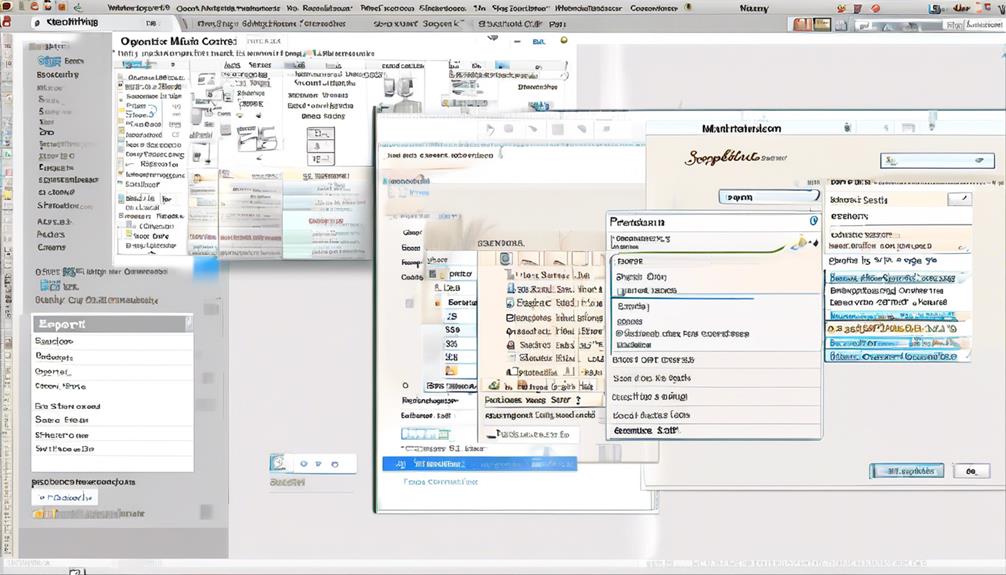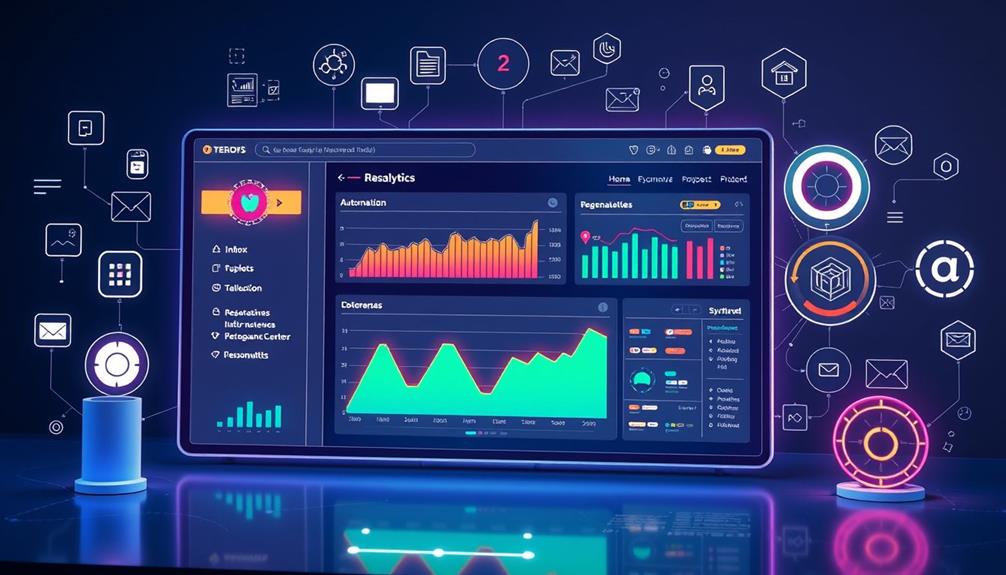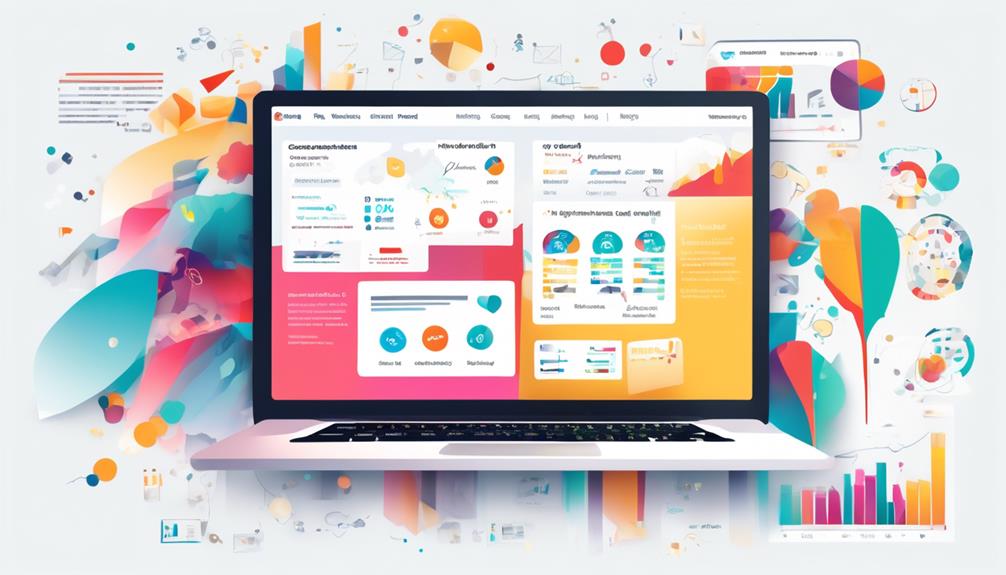An email marketing strategy is like a carefully crafted symphony, where each note is intentionally placed to resonate with the audience. It combines creativity and analytics by blending captivating storytelling with data-driven insights to deliver impactful messages.
From crafting personalized messages to analyzing performance metrics, every aspect plays a crucial role in reaching and engaging with the target audience.
But what truly sets a successful email marketing strategy apart? Join us as we unravel the intricacies of this powerful tool and explore the key components that can elevate your email marketing game to new heights.
Key Takeaways
- Personalization and segmentation are crucial components of an effective email marketing strategy, leading to higher transaction rates and ROI.
- Optimization through A/B testing and mobile-friendly design helps improve engagement and email marketing KPIs.
- Visuals and multimedia elements can significantly enhance engagement and click-through rates in email campaigns.
- Automation plays a vital role in streamlining processes, improving conversion rates, and delivering timely and personalized emails to users.
Email Marketing Strategy Overview
In crafting an effective email marketing strategy overview, we prioritize personalization, segmentation, optimization, visuals, multimedia, and automation to drive higher transaction rates, revenue, customer acquisition, engagement, and conversion rates.
Personalization is a cornerstone of successful email marketing. By tailoring content to the individual recipient, we can achieve higher transaction rates and ROI.
Segmentation is equally vital, as it allows us to target specific audience segments with tailored content, leading to increased revenue and customer acquisition.
Optimization plays a crucial role in enhancing engagement. A/B testing and mobile-friendly design are among the best practices that significantly impact email marketing KPIs.
Visuals and multimedia elevate engagement and click-through rates, making them indispensable elements of our email campaigns.
Furthermore, automation, including triggered campaigns, streamlines processes and improves conversion rates.
Incorporating these elements into our email marketing strategy ensures that we effectively reach our target audience and drive successful email marketing.
As we delve into the email marketing strategy overview, understanding the different types of emails and the selection of appropriate email service providers will further enhance the effectiveness of our campaigns.
Benefits of Email Marketing

Email marketing offers a multitude of benefits for businesses. It allows us to reach our target audience directly, increasing brand awareness and driving customer engagement. These advantages contribute to building a strong and loyal customer base. Ultimately, this leads to increased sales and revenue.
Reach Target Audience
With the ability to directly reach our target audience, email marketing ensures personalized and relevant content delivery, resulting in a significant impact on engagement and conversion rates. By sending tailored messages to our customers, we can achieve the best results for our business using email marketing.
Personalized emails have been shown to deliver 6x higher transaction rates, generating a $20 ROI for every $1 invested. Additionally, incorporating dynamic content based on user behavior can significantly improve engagement with our target audience. Utilizing personalized recommendations in emails can lead to higher conversion rates, making them an effective strategy for reaching our target audience.
It’s important to note that personalized subject lines can increase open rates by 50%, making them a crucial element for reaching our target audience effectively.
Increase Brand Awareness
To enhance our brand’s recognition and visibility, leveraging email marketing offers a strategic advantage in continually reinforcing our presence in subscribers’ inboxes.
Through our email marketing campaigns, we can effectively increase brand awareness by:
- Regularly sending engaging and informative emails, utilizing email templates and compelling email content to capture subscribers’ attention.
- Showcasing our expertise, values, and unique selling propositions to solidify our position in the market and build trust.
- Consistently telling our brand story and messaging to shape and reinforce our brand’s identity.
- Deepening connections with subscribers, turning them into loyal advocates and customers, ultimately fostering brand loyalty.
Drive Customer Engagement
Continually reinforcing our brand’s presence through email marketing not only increases brand awareness but also drives customer engagement, resulting in significant benefits for our business.
By strategically segmenting our email list and personalizing our content, we can effectively drive customer engagement.
Utilizing compelling call-to-action phrases in our email marketing campaigns encourages recipients to take the desired actions, further nurturing leads and driving conversions.
It’s important to ensure compliance with GDPR regulations to maintain the trust of our audience and safeguard their data.
Monitoring key performance indicators (KPIs) such as open rates, click-through rates, and conversion rates allows us to gauge the effectiveness of our email marketing strategy in driving customer engagement.
Types of Email Marketing
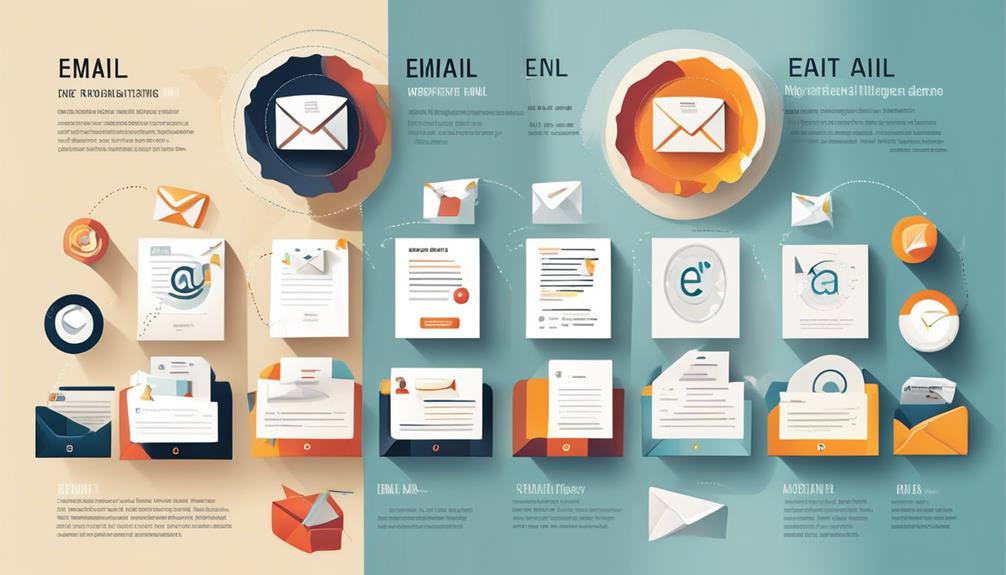
Let’s explore the different types of email marketing and the best practices for each.
Understanding the various types of emails, such as promotional, survey, seasonal, transactional, and educational, is crucial for creating targeted and effective campaigns.
Types of Emails
When crafting an email marketing strategy, it’s essential to understand the various types of emails that can be utilized to effectively engage with your audience and achieve your marketing goals.
Here are some key types of emails to consider:
- Promotional Emails: Used to reach a broad audience and maintain awareness of products or services.
- Survey Emails: Gather feedback from customers to improve offerings and understand customer preferences.
- Seasonal Marketing Emails: Tied to holidays, promoting sales and special promotions during specific times of the year.
- Transactional Emails: Provide order confirmations, shipping updates, and other transaction-related information to customers.
Understanding these types of emails can help small business owners optimize their email lists and tailor their content to best perform for their customers and prospects.
It’s also important to segment your email lists to ensure that the right messages are reaching the right people at the right time.
Best Practices
Implementing best practices in email marketing is crucial for achieving optimal engagement and conversion rates. Personalizing emails, segmenting campaigns, and A/B testing subject lines are key strategies for creating effective email marketing.
Personalized emails deliver 6x higher transaction rates, while segmented campaigns can lead to a 760% increase in company revenue. A/B testing subject lines helps determine the most effective ones, improving open rates and engagement.
Additionally, incorporating visuals and multimedia can significantly increase engagement and click-through rates. Automation is another best practice that streamlines email marketing processes and saves time, allowing marketers to focus on creating impactful content.
Crafting Compelling Content

Crafting compelling content for email marketing involves tailoring messages based on customer data to create personalized and engaging experiences. By customizing content according to user behavior and preferences, email marketers can effectively capture the attention of their audience.
Here are some tips to help create the best email content:
- Utilize Dynamic Content: Incorporate dynamic elements such as personalized recommendations and tailored product offerings to increase engagement and relevance.
- Enhance with Visuals: Use compelling visuals, videos, and GIFs to make the email content visually appealing and captivating.
- Implement Automation: Utilize automation and triggered campaigns to send timely and personalized emails based on user actions and interactions.
- Analyze Performance Metrics: Regularly measure the success of email campaigns by analyzing open rates, click-through rates, and conversion rates to optimize and refine content and strategy.
Crafting compelling content is essential for different types of emails, including promotional emails, newsletters, and transactional emails. By following these strategies, email marketers can create engaging content that resonates with their audience and drives desired actions.
Optimizing Send Times

After crafting compelling content for email marketing, the next crucial step is optimizing send times to ensure maximum engagement and effectiveness of the email campaigns. When determining the optimal time to send emails, it’s essential to consider various factors such as the behavior patterns of your target audience and their respective time zones. To maximize open and click-through rates, it’s important to test different send times and leverage analytics and A/B testing to identify the most effective time for your specific audience.
Utilizing automation tools can be instrumental in scheduling emails for optimal delivery times based on recipient preferences and engagement patterns. By sending targeted emails at the right time, you can significantly enhance the impact of your email marketing efforts. Additionally, it’s imperative to regularly review and adjust send times based on performance data to ensure continued effectiveness.
Understanding what type of content resonates with your audience and when they’re most likely to engage with it’s crucial for creating an email marketing strategy that yields favorable results. By optimizing send times, you can enhance the overall effectiveness of your email campaigns.
Subscriber Segmentation

Segmentation of your email list is an essential strategy for delivering targeted and personalized content to different subscriber segments. Subscriber segmentation involves categorizing your email list based on specific criteria such as demographics, behavior, or engagement.
Here are some key points to consider when implementing subscriber segmentation:
- Improved Relevance: By segmenting your email list, you can tailor your content to match the specific needs and interests of different subscriber segments, leading to higher open rates and engagement.
- Enhanced Engagement: Sending emails with content that resonates with each segment can result in improved customer satisfaction, loyalty, and ultimately, higher conversions.
- Compliance with GDPR: Segmentation allows you to ensure compliance with GDPR regulations by giving subscribers control over the type of content they receive, thus respecting their preferences and privacy.
- Effective Email Subject Lines: Segmentation enables you to craft personalized and compelling email subject lines that capture the attention of each segment, increasing the likelihood of your emails being opened and read.
Segmenting your email list not only allows for more targeted and personalized content, but it also helps in building a stronger relationship with your subscribers across various marketing channels. Utilizing email marketing software can streamline the process of segmenting your subscribers and creating tailored campaigns.
Mobile-Friendly Emails

Implementing subscriber segmentation not only enhances engagement and relevance but also paves the way for crafting mobile-friendly emails that cater to the diverse needs of our subscribers.
With the increasing use of mobile devices, it’s imperative to ensure that our email newsletters are easily accessible and readable on mobile. Utilizing responsive design is crucial to adapt the layout of our emails to different screen sizes, providing a seamless experience for recipients regardless of the device they use.
Testing emails on various mobile devices and email clients is essential to guarantee compatibility and optimal viewing. Furthermore, optimizing email content for easy reading on small screens is vital.
Testing Copy and Design
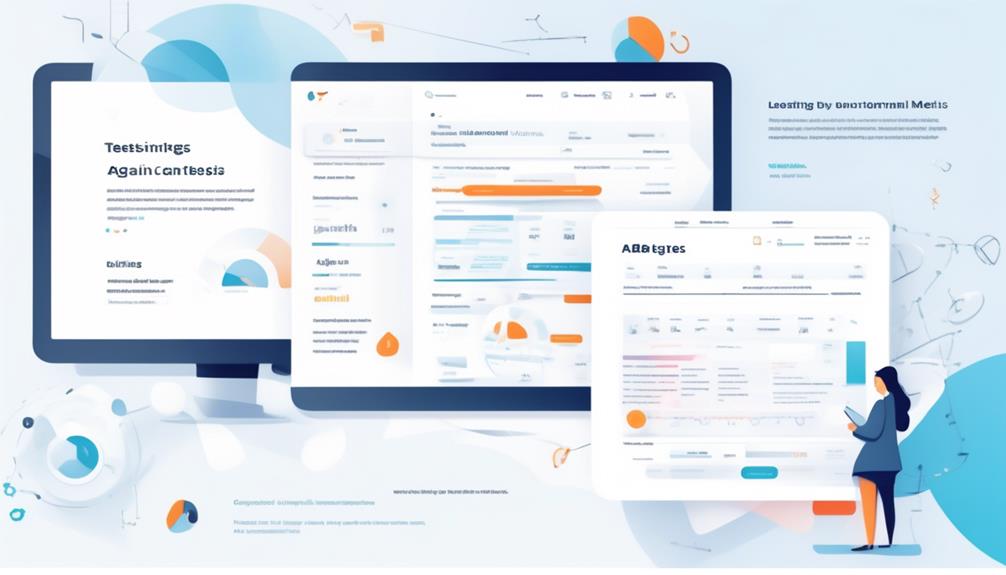
Testing different elements of email copy and design is crucial for optimizing the performance of our email marketing campaigns. By carefully testing and analyzing various components, we can refine our approach and maximize the impact of our emails.
Here’s how we can do it:
- Subject Lines: Experiment with different subject lines to see what resonates best with our audience. A compelling subject line can significantly increase open rates and drive engagement.
- A/B Testing: Test different variations of email copy, call-to-action buttons, and design elements to identify the most effective combinations. This iterative approach allows us to refine our emails based on real data and insights.
- Visuals and Multimedia: Incorporate different visuals, videos, and interactive content to see what works best in capturing the audience’s attention and driving click-through rates.
- Device Compatibility: Ensure that our emails are tested on various mobile devices and email clients to guarantee a seamless user experience for all recipients.
Spend time creating and refining emails based on the insights gathered from testing. By continuously optimizing our email content and design, we can enhance the effectiveness of our email marketing strategy and achieve better results.
Automation in Email Campaigns

We’ve all experienced the power of automation in email campaigns, from receiving personalized recommendations to timely reminders.
By leveraging automation, we can streamline our processes and ensure that our emails aren’t only relevant but also timely.
The benefits of automation are clear, and personalization is key to maximizing its effectiveness.
Email Automation Benefits
Streamlining email marketing processes and saving time, email automation offers numerous benefits in improving conversion rates and engagement with the audience.
- Increased Efficiency: Automated campaigns based on user actions can significantly improve conversion rates.
- Enhanced Engagement: Automated welcome emails have higher open and click-through rates, leading to improved engagement.
- Personalization: Utilizing behavioral data enables the creation of personalized and timely emails, enhancing customer experience.
- Optimization: Testing and optimizing automated campaigns is crucial for maximizing their effectiveness, ultimately leading to increased email marketing revenue.
Email automation also ensures compliance with regulations such as GDPR, providing peace of mind that customers’ data is used responsibly.
Personalization in Automation
Utilizing customer data to create personalized messages is a crucial aspect of automation in email campaigns, driving higher engagement and conversion rates. Personalization is integral to an effective email marketing strategy, with personalized emails delivering 6x higher transaction rates.
Dynamic content based on user behavior significantly improves engagement in automated email campaigns, while personalized recommendations lead to higher conversion rates. This strategy can generate $20 in ROI for every $1 invested, making it a highly valuable approach.
However, it’s essential for marketing managers to ensure compliance with Data Protection Regulation (GDPR), especially when personalizing emails for audiences in the European Union.
Advanced email marketing templates and lead magnets can aid in efficiently implementing personalization in automation, enhancing the overall effectiveness of email campaigns.
Subject Line Importance

The effectiveness of email marketing campaigns hinges significantly on the impact of the subject line in capturing the reader’s attention and driving email opens. When considering the importance of subject lines, it’s essential to understand the key factors that contribute to their effectiveness in email marketing strategy:
- Personalization: Utilizing personalized subject lines can significantly increase open rates by up to 50%, as it creates a sense of relevance and individualized communication for the recipient.
- A/B Testing: Conducting A/B testing on subject lines can help identify the most effective keywords and phrases that resonate with the target audience, allowing for continual improvement and optimization.
- Urgency and Scarcity: Subject lines that convey urgency or scarcity can generate higher open rates, as they prompt immediate action and create a sense of exclusivity or time sensitivity.
- Call to Action: Effective subject lines not only capture attention but also compel the reader to take action, whether it’s making a purchase, registering for an event, or engaging with the content.
Understanding the impact of subject lines is the first step in creating an important business email marketing strategy. Mastering the art of crafting compelling subject lines is crucial for driving engagement and achieving desired outcomes.
Building Email Lists

After understanding the impact of compelling subject lines, the next crucial step is to focus on building an effective email list that enhances engagement and drives desired outcomes.
To build our email list, we’ll employ lead magnets and incentives to encourage opt-ins. By offering valuable content or exclusive offers, we can entice potential subscribers to join our email list. Implementing double opt-in not only ensures the quality of our email list but also complies with regulations such as the General Data Protection Regulation (GDPR).
Regularly cleaning our email list to remove inactive subscribers is essential for maintaining high engagement rates. We’ll utilize social media and website forms to capture email addresses, expanding our reach and attracting potential subscribers.
Additionally, organizing our email list into segments based on demographics, behavior, or preferences will allow us to deliver targeted content, increasing the relevance and effectiveness of our email marketing strategy.
Regulatory Compliance

Ensuring regulatory compliance in email marketing is crucial for maintaining trust with our audience and avoiding legal repercussions. We must stay informed about laws such as CAN-SPAM, GDPR, and CASL to protect consumer rights and privacy.
Legal Requirements
In our email marketing strategy, it’s crucial to ensure compliance with data protection regulations such as GDPR and CCPA in all our activities.
To meet legal requirements, we must:
- Provide recipients with a clear and easy option to unsubscribe from email communications.
- Include a physical mailing address and company contact details in all marketing emails.
- Obtain explicit consent from individuals before sending them marketing emails.
Additionally, it’s essential to regularly review and update email marketing practices to align with evolving legal requirements.
Data Protection Laws
When navigating data protection laws, companies must prioritize secure and ethical handling and storage of personal data to maintain legal compliance and uphold customer trust. Compliance with data protection laws, such as GDPR in Europe and CCPA in California, is crucial for businesses using email marketing strategies.
Obtaining explicit consent for collecting and using personal data for marketing purposes is a fundamental requirement. Additionally, data protection laws mandate that companies provide individuals with the ability to opt out of marketing communications. Adhering to these laws not only ensures regulatory compliance but also fosters a positive relationship with customers.
Email Marketing Metrics
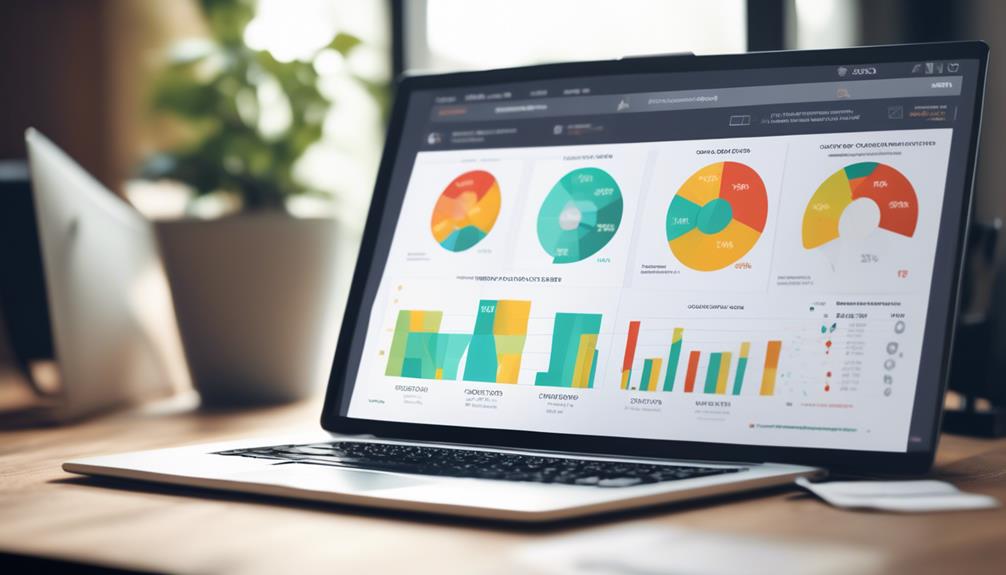
Monitoring email marketing metrics is crucial for evaluating the effectiveness of campaigns and maximizing return on investment. As we delve into the world of email marketing metrics, here are some essential metrics to consider:
- Open Rates: This metric indicates how many of your emails are opened by recipients. It provides insight into your email subject lines, timing, and overall appeal.
- Click-Through Rates: This metric measures the percentage of recipients who click on a link or multiple links within your email. It helps assess the effectiveness of your call-to-action and content.
- Conversion Rates: Tracking the percentage of recipients who take a desired action, such as making a purchase or signing up for a webinar, provides valuable insight into the impact of your email campaigns on actual product benefits.
- ROI: Calculating the return on investment from your email marketing efforts helps you understand the monetary value generated from your campaigns, enabling you to make informed decisions to grow your business.
Creating a Strategic Email Plan

To develop a strategic email plan, we must first conduct a thorough analysis of our target audience and their preferences. Understanding our audience is the first thing in creating a strategic email plan. One of the best ways to do this is by collecting data through sign-up forms, purchase history, and customer surveys. This information will help you get started on segmenting your audience based on their behaviors and interests.
It’s also a good idea to consider offering incentives such as free shipping or exclusive discounts in exchange for their email addresses. This not only encourages sign-ups but also provides value to your subscribers from the outset.
Once you have a clear understanding of your audience, the next step in creating a strategic email plan is to define your goals. Whether it’s driving sales, increasing brand awareness, or nurturing leads, having clear objectives will guide the content and frequency of your emails.
Additionally, consider the customer journey and where email marketing can provide the most value in moving subscribers towards conversion. By aligning your email marketing strategy with these insights, you can create a plan that effectively engages and converts your audience.
Can Email Marketing be Effective without Spending Money?
Yes, free email marketing strategies can be effective without spending money. By leveraging techniques such as creating valuable content, building a strong email list, and utilizing social media, businesses can reach and engage their audience without the need for a hefty marketing budget.
Frequently Asked Questions
What Is the Definition of an Email Marketing Strategy?
We define an email marketing strategy as a targeted approach that utilizes customer data to personalize messages, enhancing transaction rates and ROI. Segmentation leads to more focused campaigns and a 760% increase in company revenue, improving open rates, revenue, and leads.
Optimization involves personalized subject lines, A/B testing, and mobile-friendly designs to boost open and click-through rates. Visuals and multimedia increase engagement, especially when aligned with the brand.
Automation streamlines processes and optimizes engagement.
What Are the 4 Types of Email Marketing?
We'll cover the 4 types of email marketing.
These include promotional emails, which boost product or service awareness.
Then, survey emails gather customer feedback for improvements.
Additionally, seasonal marketing emails tie into holidays, promoting sales and specials.
Lastly, transactional emails provide order confirmations and shipping updates.
Each type plays a crucial role in a well-rounded email marketing strategy, engaging customers and driving business growth.
What Is Email Marketing and Example?
Email marketing is like a well-oiled machine, delivering targeted messages to our audience.
For instance, we use personalized recommendations just like Amazon, tailoring each email to individual preferences. This approach boosts open rates, revenue, and customer acquisition.
We also employ segmentation and optimization techniques, harnessing the power of visuals and multimedia to enhance engagement.
Automation and triggered campaigns streamline processes, saving time and improving conversion rates.
What Are the 7 Email Marketing Strategies?
We implement a variety of tactics in our email marketing strategy to drive higher transaction rates, revenue, leads, and customer acquisition.
Firstly, we utilize personalization, segmentation, and optimization techniques. This allows us to tailor our emails to individual recipients, ensuring that the content is relevant and engaging. By using personalized subject lines and A/B testing, we achieve higher open and click-through rates.
Secondly, we focus on visuals and multimedia. Our emails include relevant images, videos, and GIFs to enhance the overall user experience. This visual content helps to capture the attention of the recipients and make the emails more memorable.
Thirdly, we incorporate automation and triggered campaigns. By setting up automated workflows and sending targeted emails based on user behavior, we can deliver personalized and timely messages. This automation streamlines our processes and ensures that the right message reaches the right person at the right time.
Conclusion
In conclusion, crafting an effective email marketing strategy is like tending to a garden – it requires nurturing, attention to detail, and the right ingredients to flourish.
By understanding the benefits, types, and metrics of email marketing, we can create compelling content, optimize send times, and build compliant email lists to drive success.
With a strategic plan in place, we can cultivate meaningful relationships and yield a bountiful harvest of engagement and conversions.



